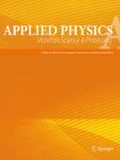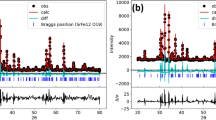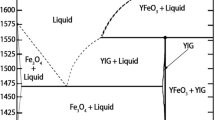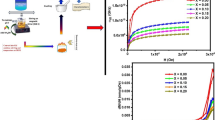Abstract
In this paper, nanocrystalline Nd[(Zn0.925Co0.075)1/2Ti1/2]O3 (NZCT75) powders were synthesized through glycine–nitrate combustion method with the intent of reducing the sintering temperature and improving the microwave dielectric properties of NZCT75 ceramics. Phase composition, structure, and morphology of the powders were analyzed by thermogravimetric analysis–differential thermal analysis (TG–DTA), Fourier transform infrared spectroscopy (FT-IR), X-ray diffraction (XRD), scanning electron microscopy (SEM), and transmission electron microscopy (TEM). The XRD results showed that the as-synthesized powder after rapid self-propagating combustion was highly crystallized and was mainly composed of NZCT75 phase and small amount of unknown phase. The unknown phase could be vanished through the calcination process of 600 °C. Compared to solid-state reaction route, a reduction of about 600 °C in the synthesis temperature for pure phase NZCT75 was realized. A large amount of pores with inhomogeneous distribution in size and shape was found from the SEM image of the as-synthesized powder due to the rapid combustion reaction between glycine and nitrates. The TEM study revealed that the average particle size of the calcined powder is around 31.9 nm. The bulk sample prepared by the nanosized powder could be sintered to 98.8% of the theoretical density at 1250 °C, reducing about 160 °C more than the solid-state reaction method. Meanwhile, excellent microwave dielectric properties of NZCT75 ceramics presented a dielectric constant of 37.17, a quality factor of 257,600 GHz, and a temperature coefficient of resonant frequency of – 29.48 ppm/oC. This study develops a facile approach to synthesize nanocrystalline powder for a promising application in microwave dielectric ceramics.









Similar content being viewed by others
Data availability
The authors confirm that the data supporting the findings of this study are available within the article.
References
Z.K. Cao, E.C. Xiao, X.H. Li, Z.X. Yue, G.H. Chen, Y. Chen, K.X. Song, H.F. Zhou, Z.M. Qi, F. Shi, Lattice vibrational characteristics, crystal structures and dielectric properties of non-stoichiometric Nd(1+x)(Mg1/2Sn1/2)O3 ceramics. J. Materiomics 6, 476–484 (2020)
A.W. Xie, J. Fu, R.Z. Zuo, X.W. Jiang, T.Y. Li, Z.Q. Fu, Y.W. Yin, X.G. Li, S.J. Zhang, Supercritical relaxor nanograined ferroelectrics for ultrahigh-energy-storage capacitors. Adv. Mater. 34, 2204356 (2022)
Z. Hanani, S. Merselmiz, A. Danine, N. Stein, D. Mezzane, M. Amjoud, M. Lahcini, Y. Gagou, M. Spreitzer, D. Vengust, Z. Kutnkaj, M. El Marssi, I.A. Luk’yanchuk, M. Goune, Enhanced dielectric and electrocaloric properties in lead-free rod-like BCZT ceramics. J. Adv. Ceram. 9, 210–219 (2020)
A. Chrzan, J. Karczewski, M. Gazda, D. Szymczewska, P. Jasinskia, La0.6Sr0.4Co0.2Fe0.8O3-δ oxygen electrodes for solid oxide cells prepared by polymer precursor and nitrates solution infiltration into gadolinium doped ceria backbone. J. Eur. Ceram. Soc. 37, 3559–3564 (2017)
C.Z. Yin, B. Liu, Z.Z. Yu, L.L. Shu, L.J. Liu, Y. Chen, C.C. Li, A low-firing melilite ceramic Ba2CuGe2O7 and compositional modulation on microwave dielectric properties through Mg substitution. J. Adv. Ceram. 10, 108–119 (2021)
Y.H. Jiang, Y.T. Shen, J. Yang, Z.X. Fang, X. Zhang, P. Zhao, B. Tang, A novel ultra-low loss ceramic Li5ZnSnNbO8 with a rock salt structure. Mater. Chem. Phys. 277, 125457 (2022)
J. Fan, Q. Zhao, K. Du, F. Wang, X.H. Wang, W.Z. Lu, W. Lei, Lattice structure and microwave dielectric properties of La[Al1−x(Mg0.5Ti0.5)x]O3 (x = 0–02)-based ceramics. J. Am. Ceram. Soc. 103, 3231–3237 (2020)
T. Yu, T. Luo, Q.H. Yang, H.H. Feng, H.T. Yu, J.S Liu, Ultra-high quality factor of Mg6Ti5O16-based microwave dielectric ceramics with temperature stability. J. Mater. Sci. Mater. Electron. 32, 2547–2556 (2021)
J.M. Li, C.G. Fan, Z.X. Cheng, S.L. Ran, Influence of Zn nonstoichiometry on the phase structure, microstructure and microwave dielectric properties of Nd(Zn0.5Ti0.5)O3 ceramics. J. Alloys Compd. 793, 385–392 (2019)
C.F. Tseng, Substituting effects of Zn on microstructural characteristics and microwave dielectric properties of Nd(Co1/2Ti1/2)O3 ceramics. J. Am. Ceram. Soc. 91, 4101–4104 (2008)
J.M. Li, C.G. Fan, L.C. Yao, T. Qiu, Effects of Co substitution on structure and microwave dielectric properties of Nd(Zn0.5Ti0.5)O3 ceramics. Chin. J. Process Eng. 18, 411–416 (2018)
J.M. Li, L.C. Yao, T. Qiu, S.L. Ran, C.G. Fan, Sintering behavior, crystal structure and microwave dielectric properties of (1–x)Nd[(Zn0.7Co0.3)05Ti0.5]O3-x(Na0.5Nd0.5)TiO3 ceramics. J. Alloys Compd. 726, 261–268 (2017)
L.X. Chen, Q.Q. Chen, Z.Y. Xue, S.S. Liu, S. Wang, S.K. Xu, Controllable synthesis of α-Fe2O3 nanocubes with size-dependent optical performance. NANO 17, 2250030 (2022)
H. Huang, J. Tang, J. Liu, Preparation of Na0.5Bi0.5TiO3 ceramics by hydrothermal- assisted cold sintering. Ceram. Int. 45, 6753–6758 (2019)
S. Thambidurai, P. Gowthaman, M. Venkatachalam, S. Suresh, M. Kandasamy, Morphology dependent photovoltaic performance of zinc oxide-cobalt oxide nanoparticleinanorod composites synthesized by simple chemical co-precipitation method. J. Alloys Compd. 852, 156997 (2021)
M.M. Shehata, S.A. Waly, Y.A. Abdelaziz, Effect of Gd3+ doping on structural and optical properties of MgO-MgAl2O4 nanocomposites synthesized via co-precipitation method. J. Mater. Sci. Mater. Electron. 32, 7423–7430 (2021)
D. Di Lecce, T. Hu, J. Hassoun, Electrochemical features of LiMnPO4 olivine prepared by sol–gel pathway. J. Alloys Compd. 693, 730–737 (2017)
M. Munir, A. Hussain, J.-Y. Ock, J.-H. Son, S.A. Khan, D.-S. Bae, Structure analysis and ferroelectric response of Bi0.5Na0.5TiO3 nanopowder synthesized by sol-gel method. J. Nanosci. Nanotechnol. 19, 1323–1329 (2019)
L. Singh, I.W. Kim, B.C. Sin, S.K. Woo, S.H. Hyun, K.D. Mandal, Y. Lee, Combustion synthesis of nano-crystalline Bi2/3Cu3Ti2.90Fe0.10O12 using inexpensive TiO2 raw material and its dielectric characterization. Powder Technol. 280, 256–265 (2015)
Z.X. Yue, Y. Zhang, Z. Gui, L.T. Li, Preparation and characterization of CaTiO3–(Li1/2Nd1/4Sm1/4)TiO3 microwave ceramics by a sol–gel combustion process. Appl. Phys. A 80, 1757–1761 (2005)
M. Shkir, M. Arif, A. Singh, I.S. Yahia, H. Algarni, S. AlFaify, A facile one-step flash combustion synthesis and characterization on C doped NiO nanostructures. Mater. Sci. Semicon. Proc. 100, 106–112 (2019)
M.N. Smirnova, G.E. Nikiforova, L.V. Goeva, N.P. Simonenko, One-stage synthesis of (Y0,5Bi0,5)3(Fe0,5Ga0,5)5O12 garnet using the organometallic gel auto-combustion approach. Ceram. Int. 45, 4509–4513 (2019)
H.V. Vasei, S.M. Masoudpanah, M. Adeli, M.R. Aboutalebi, Photocatalytic properties of solution combustion synthesized ZnO powders using mixture of CTAB and glycine and citric acid fuels. Adv. Powder Technol. 30, 284–291 (2019)
M.K. Lee, S. Kang, A study of salt-assisted solution combustion synthesis of magnesium aluminate and sintering behavior. Ceram. Int. 45, 6665–6672 (2019)
P. Chen, L.W. Jiang, S.S. Yang, H.B. Chen, J. He, Y. Wang, J. An, Effects of combustion agents on the synthesis of perovskite erbium ferrite (ErFeO3) nanocrystalline powders fabricated by auto-propagating combustion process. Inor. Chem. Commun. 101, 164–171 (2019)
W.Q. Liu, X.G. Liu, P.P. Zhang, Z.Y. Wang, X. Li, M.C. Hu, Nano-sized plate-like alumina synthesis via solution combustion. Ceram. Int. 45, 9919–9925 (2019)
L.S. Lobo, A.R. Kumar, Structural and electrical properties of ZnCo2O4 spinel synthesized by sol-gel combustion method. J. Non-Cryst. Solids 505, 301–309 (2019)
R.E. Khalfaouy, A. Addaou, A. Laajeb, A. Lahsini, Synthesis and characterization of Na-substituted LiMnPO4 as a cathode material for improved lithium ion batteries. J. Alloys Compd. 775, 836–844 (2019)
G.H. Han, Y.Q. Liu, W.W. Yang, S. Geng, W.B. Cui, Y.S. Yu, Fabrication, characterization, and magnetic properties of exchange-coupled porous BaFe8Al4O19/Co0.6Zn0.4Fe2O4 nanocomposite magnets. Nanoscale 11, 10629 (2019)
R.D. Shannon, Revised effective ionic radii and systematic studies of interatomie distances in halides and chaleogenides. Acta Cryst. A32, 751–767 (1976)
J.M. Li, C.M. Zhang, H. Wang, C.G. Fan, A facile chemical route to prepare Nd[(Zn0.7Co0.3)0.5Ti0.5]O3 powders and microwave dielectric materials. J. Sol-Gel Sci. Techn. 95, 375–383 (2020)
J.M. Li, H. Wang, J. Tan, C.G. Fan, Low temperature sintering and microwave dielectric properties of Nd[(Zn0.7Co0.3)0.5Ti0.5]O3 ceramics derived from the powders synthesized by ethylenediaminetetraacetic acid precursor route. Ceram. Int. 45, 24044–24051 (2019)
R. Venkatesh, N. Dhananjaya, M.K. Sateesh, J.P.S. Begum, S.R. Yashodha, H. Nagabhushana, C. Shivakumara, Effect of Li, Na, K cations on photoluminescence of GdAlO3:Eu3+ nanophosphor and study of Li cation on its antimicrobial activity. J. Alloys Compd. 732, 725–739 (2018)
Y.T. Prabhu, K.V. Rao, V.S. Sai Kumar, B. Siva Kumari, X-Ray analysis by Williamson-Hall and size-strain plot methods of ZnO nanoparticles with fuel variation. J. Nano Sci. Eng. 4, 21–28 (2014)
M. Khodaei, S. Fayazzadeh, Magnetic properties of CoFe2O4 nanoparticle synthesized by salt-assisted sol-gel auto-combustion method. Mater. Res. Express 6, 086115 (2019)
O. Kaygili, Synthesis and characterization of Fe-containing biphasic calcium phosphate ceramics. J. Aust. Ceram. Soc. 55, 381–385 (2019)
O. Kaygili, Combustion synthesis and characterization of Mg-based Fe-doped biphasic calcium phosphate ceramics. Appl. Phys. A 125, 431 (2019)
M. Sukumar, L.J. Kennedy, J.J. Vijaya, B.A. Najar, M. Bououdin, Facile synthesis of Fe3+ doped La2CuO4/LaFeO3 perovskite nanocomposites: structural, optical, magnetic and catalytic properties. Mater. Sci. Semicon. Proc. 100, 225–235 (2019)
S. Pratibha, N. Dhananjaya, S.R. Manohara, L.S.R. Yadav, Effect of Sm3+, Bi3+ ion doping on the photoluminescence and dielectric properties of phytosynthesized LaAlO3 nanoparticles. J. Mater. Sci. Mater. Electron. 30, 6745–6759 (2019)
C.J. Dong, X.C. Xiao, G. Chen, H.T. Guan, Y.D. Wang, Morphology control of porous CuO by surfactant using combustion method. Appl. Surf. Sci. 349, 844–848 (2015)
Y.Z. Zhu, S.P. Lin, Y. Liu, D.C. Ma, B. Wang, Efficient synthesis of stoichiometric lithium tantalate powder by a solid-state combustion route. Mater. Manuf. process 30, 1342–1347 (2015)
M. Liu, D. Xue, An efficient approach for the direct synthesis of lithium niobite powders. Solid State Ionics 177, 275–280 (2006)
H.R. Tian, X. Zhou, T.Y. Jiang, J.L. Du, H.T. Wu, Y.Z. Lu, Y.Y. Zhou, Z.X. Yue, Bond characteristics and microwave dielectric properties of (Mn1/3Sb2/3)4+ doped molybdate based low-temperature sintering ceramics. J. Alloys Compd. 906, 164333 (2022)
X. Zhou, L.T. Liu, J.J. Sun, N.K. Zhang, H.Z. Sun, H.T. Wu, W.H. Tao, Effects of (Mg1/3Sb2/3)4+ substitution on the structure and microwave dielectric properties of Ce2Zr3(MoO4)9 ceramics. J. Adv. Ceram. 10, 778–789 (2021)
Y. Xiong, H.Y. Xie, Z.G. Rao, L.J. Liu, Z.F. Wang, C.C. Li, Compositional modulation in ZnGa2O4 via Zn2+/Ge4+ co-doping to simultaneously lower sintering temperature and improve microwave dielectric properties. J. Adv. Ceram. 10, 1360–1370 (2021)
Acknowledgements
The work was financially supported by the Natural Science Foundation of Anhui Provincial Education Department (KJ2019A0054).
Author information
Authors and Affiliations
Contributions
ZW: methodology, writing—original draft. JL: conceptualization, methodology, writing—review and editing, supervision. YG: investigation, data curation, DX: methodology, resources, supervision.
Corresponding author
Ethics declarations
Conflict of interest
The authors declare no conflict of interest.
Additional information
Publisher's Note
Springer Nature remains neutral with regard to jurisdictional claims in published maps and institutional affiliations.
Rights and permissions
Springer Nature or its licensor holds exclusive rights to this article under a publishing agreement with the author(s) or other rightsholder(s); author self-archiving of the accepted manuscript version of this article is solely governed by the terms of such publishing agreement and applicable law.
About this article
Cite this article
Wang, Z., Li, J., Guo, Y. et al. Phase composition, microstructure, and microwave dielectric properties of Nd[(Zn0.925Co0.075)1/2Ti1/2]O3 derived from glycine–nitrate combustion method. Appl. Phys. A 128, 973 (2022). https://doi.org/10.1007/s00339-022-06125-4
Received:
Accepted:
Published:
DOI: https://doi.org/10.1007/s00339-022-06125-4




